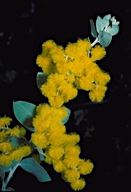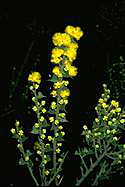

 |
Australian National Botanic Gardens
|
 |
A weekly news sheet prepared by a Gardens' volunteer.
Numbers in square brackets [] refer to garden bed Sections.
Plants in flower are in bold type.
31 August 2007
 |
Acacia podalyriifolia - click for larger image |
Wattle Week, and there are many different wattles in flower. This week’s walk starts on the road behind the Café and leads up to one of the older Acacia sections, with much to see on the way. On the right of the road, just before a corner where another road branches right, a stiff Acacia siculiformis [Section 128], aptly called Dagger wattle, has solitary deep cream ball flowers. On either side of this Acacia, Grevillea rosmarinifolia ‘Rosy Posy’ [Section 128] looks attractive with dark green leaves and large, hanging clusters of pink-red flowers.
Turning into the road on the right, Acacia podalyriifolia [Section 126] has soft, silver-grey phyllodes and large clusters of bright, golden-yellow flower balls. Further along, still on the right, Westringia eremicola[Section 127] has dainty clusters of mauve flowers. Below some small plants of Leucopogon melaleucoides [Section 127] have pinkish buds followed by tiny, furry white flowers. At the corner opposite a large Brittle Gum, turn left and on the left a beautiful Geralton Wax, Chamelaucium ‘Murfit Rose’ [Section 124) has deep red buds and pink flowers which age to near white. On the right Prostanthera ‘Poorinda Petite’ [Section 6] shows off deep mauve flowers against dark green, aromatic foliage.
At the Rockery take the Main Path to the right. Opposite the waterfall, Guichenotia ledifolia [Section 4] with soft greyish foliage displays profuse pinkish down-turned flowers. At the top of the second steps on the left, a Cauliflower Hakea, Hakea corymbosa [Section 15P] is full of greenish flowers amidst stiff, spiky foliage. Turning right, low-growing Leucopogon fraseri [Section 15K] on the left draws the eye with its numerous pink tube flowers. On the left of a seat, a prostrate Grevillea sp. [Section 14] has lovely red and cream ‘toothbrush’ flowers. Just beside it, don’t miss the small Olearia rudis [Section 14] with conspicuous, pale blue daisy flowers. Still on the left, set back into the bed, a Northern Territory species, Rulingia magniflora [Section 14] has large clusters of bright pink flowers contrasting with grey-green leaves. Still on the left, Eremophila subfloccosa subsp. subfloccosa [Section 14] has bright lime-green flowers protruding from crowded, woolly, grey-green leaves.
 |
Acacia pravifolia - click for larger image |
Take the steps up and turn left onto the road. Opposite is one of the original Acacia beds. Deep in the bed near the corner, the Mt Buffalo wattle, Acacia phlebophylla [Section 3] has broad leathery phyllodes and yellow rods of flowers. Opposite Spyridium obovatum var. obovatum [Section 14] is covered with small clusters of woolly yellow flowers. A dwarf shrub, Acacia epacantha [Section 14] on the corner of a path into the Rockery, has solitary yellow ball flowers above the middle of its spines. Acacia pravifolia [Section 15H] is a rigid, much branched shrub with interesting triangular phyllodes and bright golden yellow flowers. Which way now, left into the Rockery or up into the Acacia section?
The choice is yours… Kath Holtzapffel